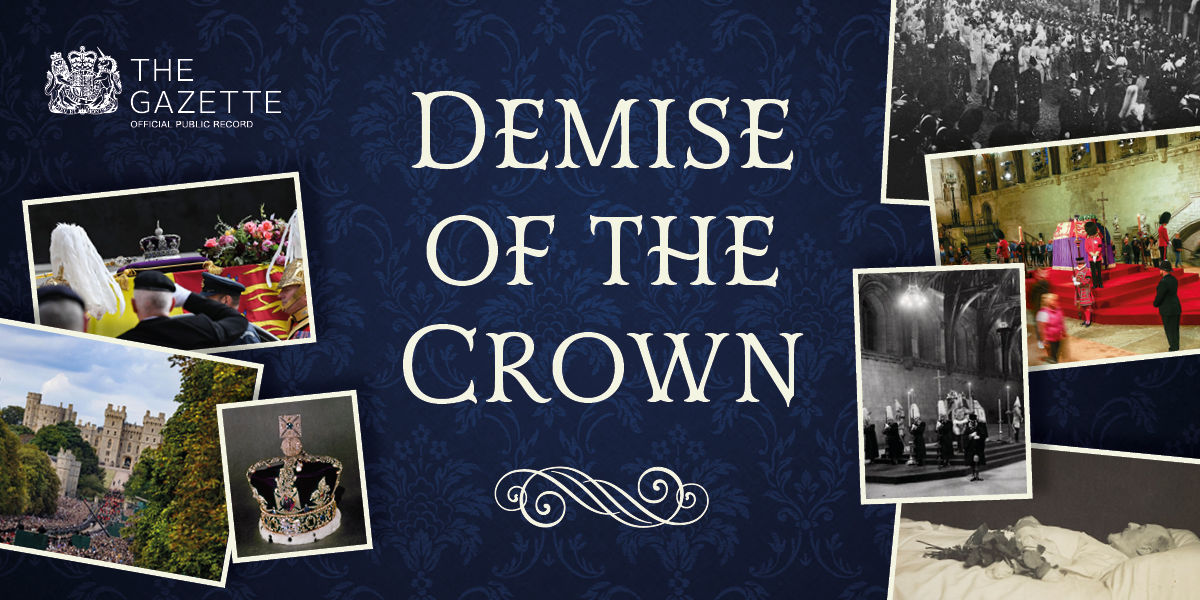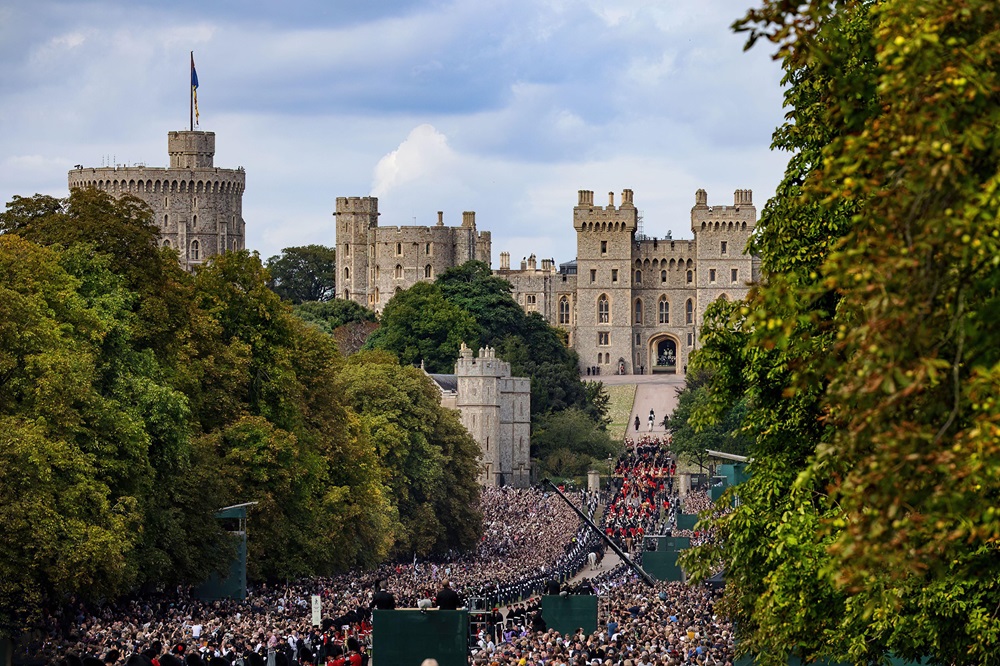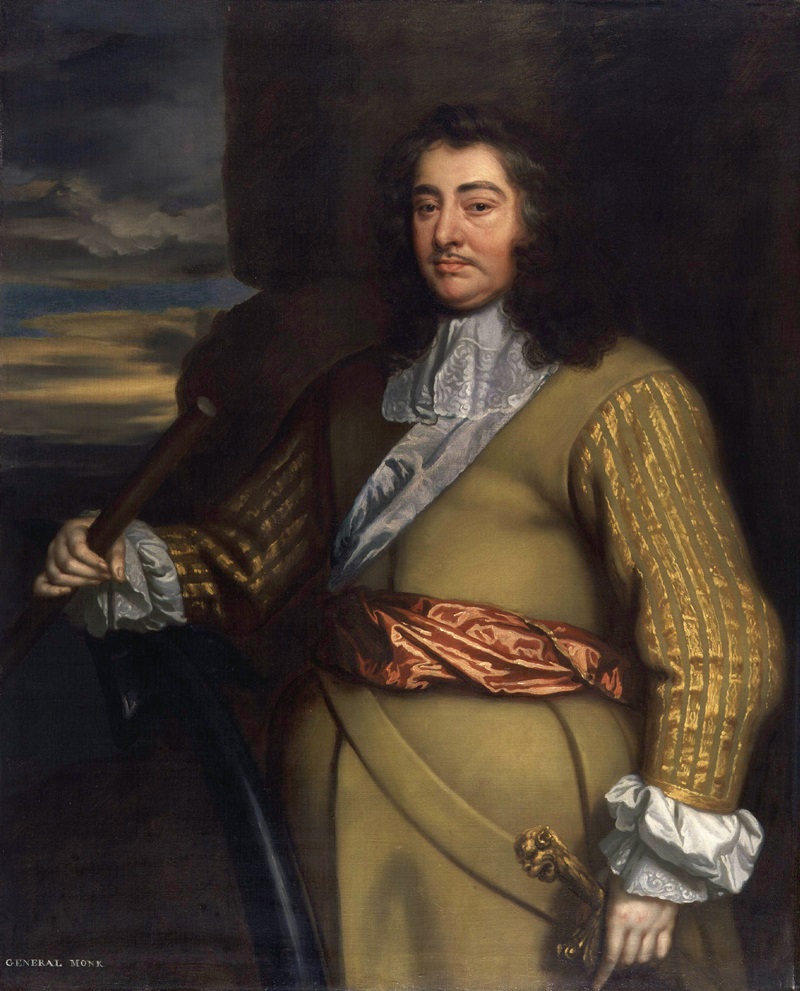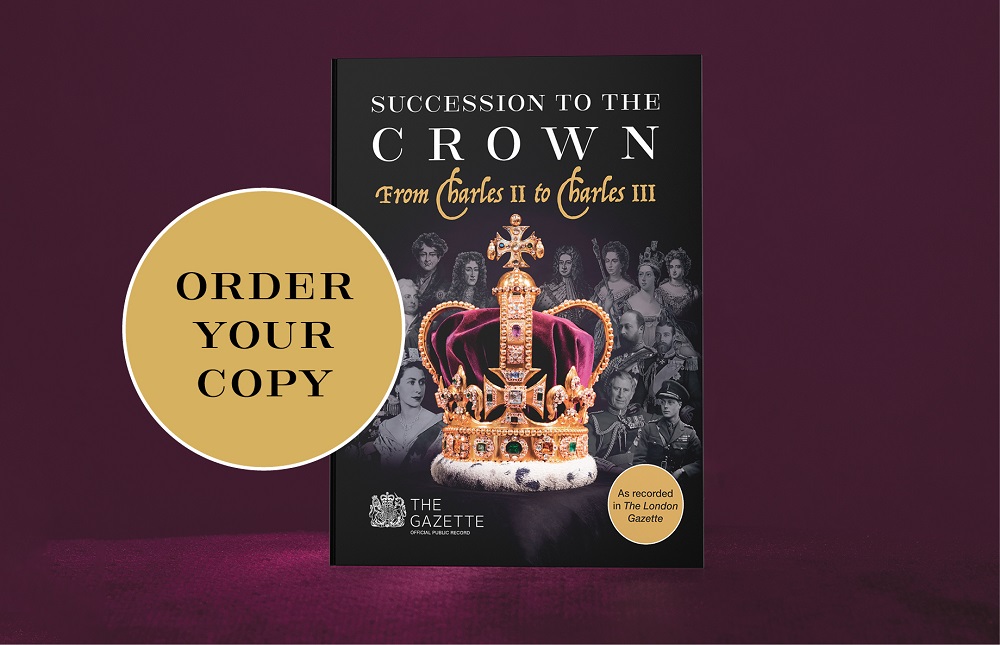Demise of the Crown: #1: An introduction

As the official public record since 1665, The Gazette has been recording the deaths of monarchs for over three centuries. As part of our ‘Demise of the Crown’ series, historian Russell Malloch looks through the archives at The Gazette’s reporting of events following the demise of sovereigns, their consorts, and other senior members of the royal family.
Introduction
In 2023, The Gazette published a paperback about the Succession to the Crown, an event The Gazette had reported since the death of Charles II in 1685, and happened most recently with the passing of Elizabeth II. The Gazette recorded only two exceptions to the “demise by death” rule, which arose in 1689 when James II was deprived of the crown, and in 1936 when Edward VIII abdicated.
The transfer of the royal authority, including the role of the accession council that followed the demise of the crown, was dealt with in the 2022 book, while this series of articles deals with The Gazette’s reporting of events following the demise of sovereigns, their consorts, and other senior members of the royal family.
Events connected with the demise of the crown were highlighted in The Gazette of July 2024 (Gazette issue 64462), which published the programme for two of the many ceremonies that were organised after the death of Queen Elizabeth II, namely her state funeral in Westminster Abbey, and the committal service at Windsor Castle in September 2022.
The series begins by examining The Gazette’s reporting of royal obsequies or funeral rites in the 17th and 18th centuries, before considering the arrangements for the last three Hanoverian ceremonies during the first half of the 19th century, and then the circumstances relating to the demise of the six sovereigns from Victoria in 1901 to Elizabeth in 2022.
The articles will also examine The Gazette’s recording of:
- the decease of royal consorts, and a few of the sovereigns’ children and siblings
- the honours conferred in connection with the death of family members
- the provisions to regulate the court and public mourning
- other matters that arose following the demise of the crown
Some points of contrast emerge in the organisation of royal funerals and the related Gazette content, as shown by the regular accounts relating to the passing of home-based members of the British family, while those princesses who married into European houses and their descendants usually fell outside the reach of The Gazette’s reporters, as in the case of George III’s sister who married the king of Denmark, and Edward VII’s sister who became the queen of Prussia.
Early Gazettes
The Gazette’s approach to reporting matters relating to the demise of the crown has varied since the official public record began in 1665, although only to a limited extent. Some of the commentaries were extensive and provided the names and status of those who took part in the ceremonial, while other reports noticed some of the offices that were assigned a role, but without naming the office-holder. The briefest report about the passing of a monarch related to William III in 1702, as The Gazette provided no more than a general outline of what happened at his departure (Gazette issue 3800).
The Gazette has reported the funeral rites relating to the demise of every sovereign since 1685, but with three exceptions, as James II and Edward VIII died in exile in France, in 1701 and 1972, while George I expired in Hanover in 1727.
The Gazette’s record reflects a fairly consistent approach to the public way of marking the loss of the sovereign, despite the passage of more than 300 years. Few changes were made to the key components, even after the end of long reigns, during which political, religious and social conditions evolved through two generations or more, as happened in the reigns of George III (1760-1820), Victoria (1837-1901) and Elizabeth II (1952-2022). In particular, the religious rites of the Church of England prevailed throughout, and the display of royal regalia, and the use of the emblems of the Most Noble Order of the Garter, as well as the presence of officers of arms, and men of the royal body guards, can be found in accounts from across the centuries.

Royal Consorts
The Gazettes of the 18th and 19th centuries noticed the funerals of some consorts of the sovereign, with accounts about the services for the husbands of Queen Anne and Queen Victoria, and the wives of four Hanoverian kings, from Caroline of Brandenburg-Anspach in 1737, through Charlotte of Mecklenburg-Strelitz in 1818 and Caroline of Brunswick-Wolfenbuttel in 1821, to Adelaide of Saxe-Meiningen in 1849. The ceremonial that was observed for the German princesses provide the precedents for the four more recent funerals of royal consorts: Alexandra of Denmark in 1925, Mary of Teck in 1953, Elizabeth Bowes-Lyon in 2002, and Philip Mountbatten in 2021.
One of The Gazette’s earliest reports about a royal funeral dealt with the loss of a consort, Anne Hyde (Gazette issue 563), the first wife of James II, who died in 1671 while her husband was still the Duke of York, and heir presumptive to the crown.
The Gazette also noticed the passing of royal children, and a few of the sovereign’s remoter relatives, although the death of adult members of the Stuart family was a rare occurrence. This was because King Charles I had no surviving siblings apart from Elizabeth of Bohemia (who died in 1662), while Charles II and James II had only two sisters who had surviving children. The lives of those sisters, Henrietta of Orleans, and Mary of Orange, were centred on courts in France and the Netherlands rather than England, and they were not extensively reported in The Gazette, although The Gazette did notice the funeral of the Duchess of Orleans in Paris in 1670 (Gazette issue 484).
The Gazette recorded a series of royal births during the late 17th century, but – with the exception of the future queens Mary and Anne, and Prince James in 1688 – they all expired within a few days, or while they were still infants, and there were no accounts of any elaborate ceremonial connected with the burial of their remains. One of the earliest reports about the loss of an infant was gazetted in 1669 and related to the ten-month-old daughter of Anne Hyde and the Duke of York. Her service was held in Westminster Abbey in London, in the chapel containing the tomb of the Tudor king Henry VII:
“On Monday the 15 instant in the morning, dyed at St James’s the young lady Henrietta, youngest daughter to their Royal Highnesses, after a fortnights distemper, to the great grief of their Royal Highnesses and the whole court, and on Friday in the evening was honourably enterred in Henry the 7ths Chappel at Westminster, his Highness Prince Rupert and several eminent persons of the court assisting at the enterrment.” (Gazette issue 419)
The 17th century Gazette noticed a few non-royal funerals, and there were a number of rare examples after that, including the Duke of Marlborough in 1722 (Gazette issue 6084), Sir Isaac Newton in 1727 (Gazette issue 6569), the naval hero Horatio Nelson after he fell at the battle of Trafalgar in 1805 (Gazette issue 15881), and three of the United Kingdom’s prime ministers: William Pitt in 1806 (Gazette issue 15895), the Duke of Wellington in 1852 (Gazette issue 21388), and William Gladstone in 1898 (Gazette issue 26980).

Albemarle service
One of The Gazette’s earliest funeral reports related to George Monck, Duke of Albemarle who had helped to secure the restoration of the monarchy in 1660, and was a knight of the Order of the Garter (Gazette issue 465). The account of the 1670 ceremonial is of value in helping to place the royal ritual in the context of the contemporary practices, in so far as they were described in The Gazette.
The Albemarle funeral was held in Westminster Abbey, which was well-known as the setting for the coronation ritual, and was the focus for most of the royal departures until the start of the 19th century. The duke’s cavalcade was planned on a grand scale, involving the presence of soldiers, peers, bishops, knights, judges, personal servants, and officers of the royal household. Heraldic banners were put on show, and a chariot drawn by six horses contained an effigy of Albemarle “in azure armor; a golden truncheon in his hand, having on his ducal robe and coronet, a collar of the Order about his neck, and a Garter on his left leg.”
The use of such effigies for the funerals of the nobility, and for the passing of other grand ladies and gentlemen, continued in some circles until the middle of the 18th century. A life-sized image of the deceased was made in wood, wax or some other material, and was typically covered with their robes and insignia, as with Albemarle’s ducal robe and Garter collar. After the body was interred, the effigy might then be put on display close to the grave, or at some other suitable location.
The sermon at Albemarle’s funeral was preached by the bishop of Salisbury (and chancellor of the Order of the Garter), and after that “the four officers of the deceased duke broke their white staves at the head of the hearse, and Garter proclaimed the stile of his grace according to custom; then the trumpets sounding, the regiments and troops which were drawn up near the abbey gave their several vollies.”
The basic pattern of the Albemarle service was followed at the royal funerals that were gazetted after the duke’s death in 1670. For example:
- the Christian service and its setting came from the Church of England
- the coffin was accompanied by individuals connected with the deceased
- there were heraldic and military elements to the cavalcade
- the person’s style was proclaimed, before the emblems of offices relating to the deceased were placed in their grave
Such an approach to a member of the Stuart family was clear from the account relating to the demise of Anne Hyde in 1671, as her body was borne from the Painted Chamber in the Palace of Westminster by the King’s cousin Prince Rupert
“who appeared as chief mourner, and by most of the nobility, who followed in order; the kings and officers of arms giving their attendance; their Majesties and Royal Highnesses servants, and several gentlemen and persons of quality preceding the corps, to the place of enterment (which was in a large vault on the south side of King Henry VII Chappel in Westminster Abby) with the solemnities usually practiced on the like occasions.” (Gazette issue 563)

Succession to the Crown: From Charles II to Charles III
Succession to the Crown is essential reading for anyone with a keen interest in the British royal family and provides an excellent and trusted source of information for historians, researchers and academics alike. The book takes you on a journey exploring the coronations, honours and emblems of the British monarchy, from the demise of King Charles II in 1685, through to the accession of King Charles III, as recorded in The London Gazette.
Historian Russell Malloch tells the story of the Crown through trusted, factual information found in the UK's official public record. Learn about the traditions and ceremony engrained in successions right up to the demise of Queen Elizabeth II and the resulting proclamation and accession of King Charles III.
Available to order now from the TSO Shop.
About the author
Russell Malloch is a member of the Orders and Medals Research Society and an authority on British honours. He authored Succession to the Crown: From Charles II to Charles III, which explores the coronations, honours and emblems of the British monarchy.
See also
King Charles III and The Gazette
Gazette Firsts: The history of The Gazette and monarch funerals
Find out more
Succession to the Crown: - From Charles II to Charles III (TSO shop)
Images
The Gazette
David Betteridge / Alamy Stock Photo
National Portrait Gallery
The Gazette
Publication date
7 October 2024
Any opinion expressed in this article is that of the author and the author alone, and does not necessarily represent that of The Gazette.
